Earth’s most advanced planetary robot ever has successfully bored into the interior of Martian rock and collected fresh samples in a historic first time feat in humankinds exploration of the cosmos.
NASA’s Curiosity drilled a circular hole about 0.63 inch (16 mm) wide and about 2.5 inches (64 mm) deep into a red slab of fine-grained sedimentary rock rife with hydrated mineral veins of calcium sulfate – and produced a slurry of grey tailings surrounding the hole. The team believes this area repeatedly experienced percolation of flowing liquid water eons ago when Mars was warmer and wetter – and potentially more hospitable to the possible evolution of life.
The precision drilling took place on Friday, Feb. 8, 2013 on Sol 182 of the mission and images were just beamed back to Earth today, Saturday, Feb 9. The rover simultaneously celebrates 6 months on the Red Planet since the nail biting touchdown on Aug. 6, 2012 inside Gale Crater.
The entire rover team is overjoyed beyond compare after nearly a decade of painstakingly arduous efforts to design, assemble, launch and land the Curiosity Mars Science Laboratory (MSL) rover that culminated with history’s first ever drilling and sampling into a pristine alien rock on the surface of another planet in our Solar System.
“The most advanced planetary robot ever designed now is a fully operating analytical laboratory on Mars,” said John Grunsfeld, NASA associate administrator for the agency’s Science Mission Directorate.
“This is the biggest milestone accomplishment for the Curiosity team since the sky-crane landing last August, another proud day for America.”
Drilling goes to the heart of the mission. It is absolutely essential for collecting soil and rock samples to determine their chemical composition and searching for traces of organic molecules – the building blocks of life. The purpose is to elucidate whether Mars ever offered a habitable environment suitable for supporting Martian microbes, past pr present.
The high powered drill was the last of Curiosity’s 10 instruments still to be checked out and put into full operation.
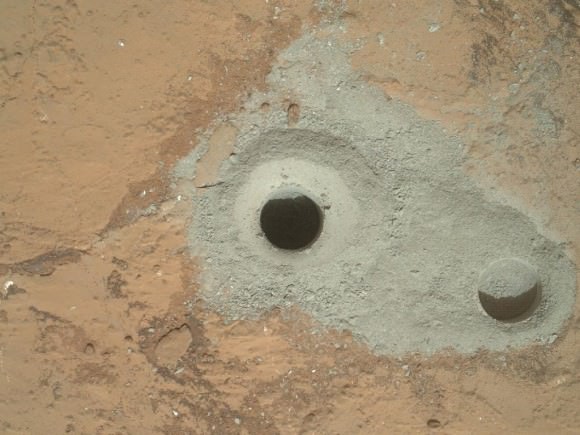
The rover plunged the rotary-percussion drill located on the end of her 7 foot (2.1 m) robot arm into a flat outcrop of rocks named “John Klein”; where she is currently toiling away inside a shallow basin named Yellowknife Bay, and that witnessed many episodes of streaming water billions of years ago.
Ground controllers will now command the rover to pulverize and sieve the powdery rocky material through screens that will filter out any particles larger than six-thousandths of an inch (150 microns) across.
Thereafter comes the ultimate test – when the processed Martian powders are delivered by the robot arm to Curiosity’s miniaturized CheMin and SAM analytical labs though a trio of inlet ports located atop the rover deck for thorough analysis and scrutiny.
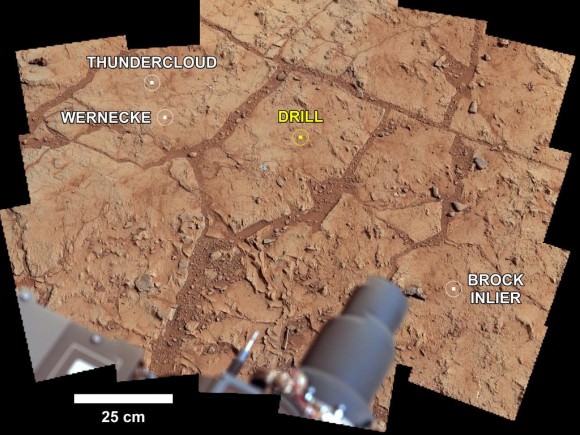
“We commanded the first full-depth drilling, and we believe we have collected sufficient material from the rock to meet our objectives of hardware cleaning and sample drop-off,” said Avi Okon, drill cognizant engineer at NASA’s Jet Propulsion Laboratory (JPL), Pasadena.
Rock tailings generated from the 5/8 inch (16 mm) wide drill bit traveled up narrow flutes on the bit and then inside the drill’s chambers for transfer to the process handling mechanisms on the arm’s tool turret.
“We’ll take the powder we acquired and swish it around to scrub the internal surfaces of the drill bit assembly,” said JPL’s Scott McCloskey, drill systems engineer. “Then we’ll use the arm to transfer the powder out of the drill into the scoop, which will be our first chance to see the acquired sample.”
A portion of the material will first be used to scour and cleanse the labyrinth of processing chambers of trace contaminants possibly brought from Earth before launch from Cape Canaveral, Florida back in Nov. 2011.
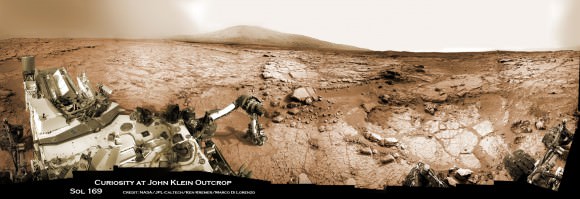
The rock Curiosity drilled is called “John Klein” in memory of a Mars Science Laboratory deputy project manager who died in 2011.
Curiosity represents a quantum leap in capability beyond any prior landed mission on the Red Planet. The car sized 1 ton rover sports 10 state-of-the-art science instruments from the US and collaborators in Europe.
The 1 ton robot will continue working for several additional weeks investigating Yellowknife Bay and the Glenelg area – which lies at the junction of three different types of geologic terrain.
Thereafter, the six-wheeled mega rover will set off on a nearly year long trek to her main destination – the sedimentary layers of the lower reaches of the 3 mile (5 km) high mountain named Mount Sharp – some 6 miles (10 km) away.
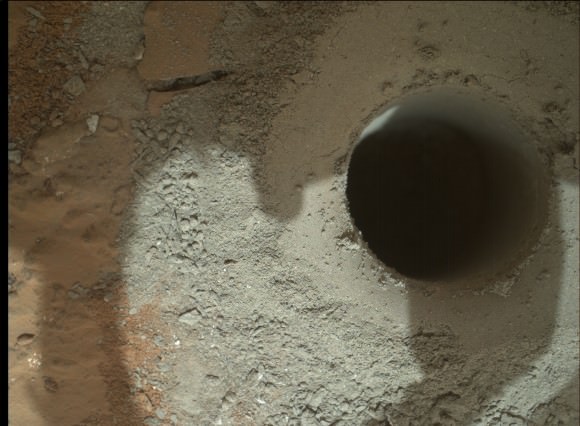
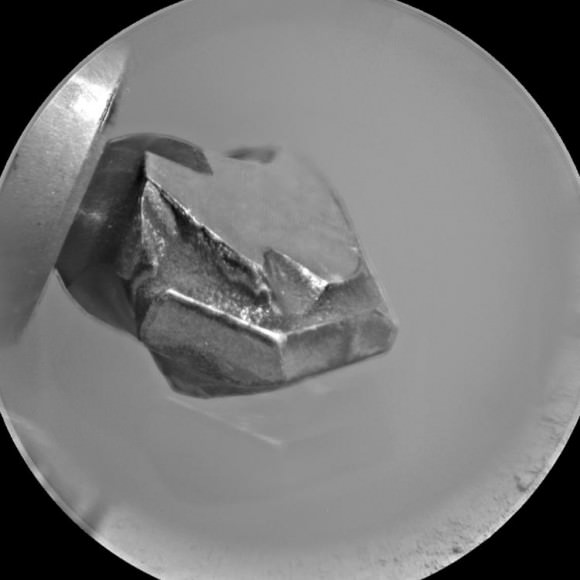

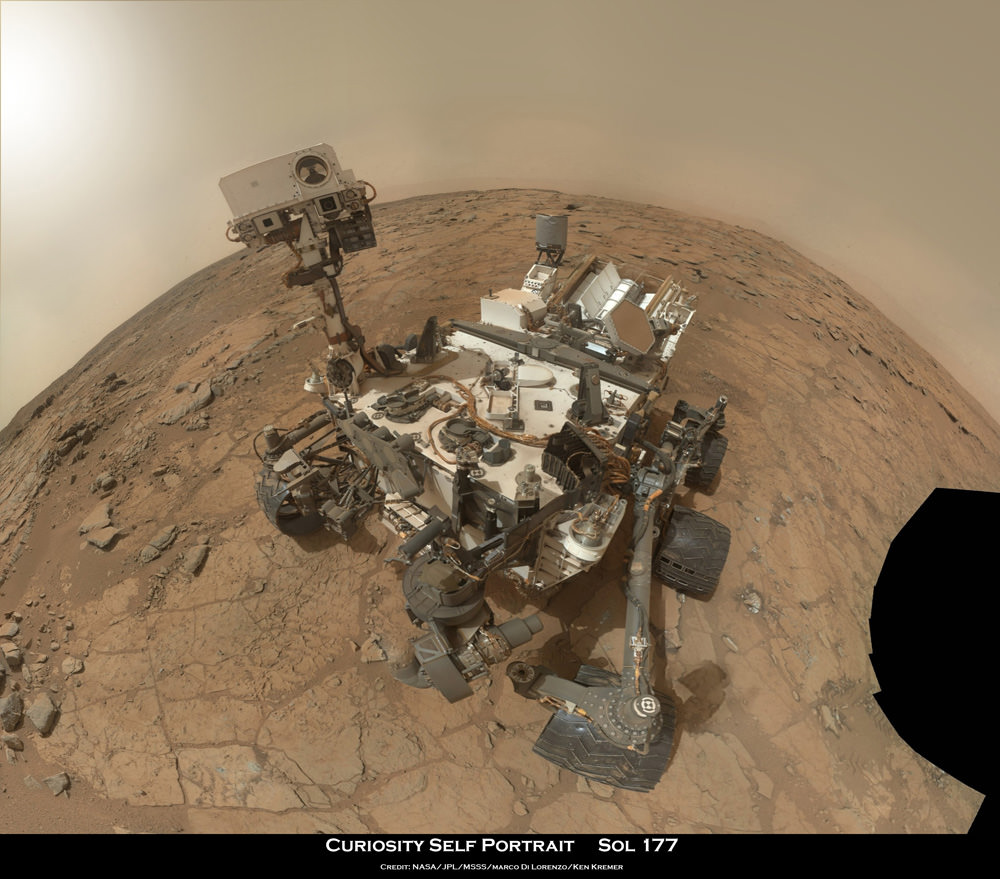
This is just so WAY double extra groovy cool! Another success! YES! I can’t wait to see the results from this historic ‘milestone’! HOW hard is that rock? WHAT is the composition? Hello!!! (Gone now to the MSL ‘raw images’ page!)
P.S. Thanks for being there for us on the weekend Ken.. you ROCK too!
Thanks ! we’ll find out more in coming sols. enjoy !
“‘…deep into a red slab of fine-grained sedimentary rock…”
I hate to be anal, but the rock is actually grey as reported on last week’s Space hangout from CosmoQuest and covered in red dust. GREAT article though. This is EPIC! Amazing how most people have no idea how fast and quickly we’re headed to the sky. So under the mainstream radar. I’m glad UT and CosmoQuest and Planetary Society are all helping popularize space science! Thanks, all!